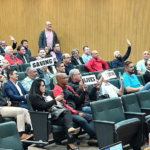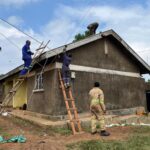Task 200
Global Land Data Assimilation System (GLDAS)
Principal Investigator(s):
H. K. Beaudoing
Sponsor(s):
M. Rodell
Last Updated:
October 26, 2012 15:25:42
Description of Problem
Land surface states and fluxes influence the weather and climate through exchanges of energy, water, and momentum between land and atmosphere. The energy and water stored in land present persistence on diurnal, seasonal, and inter-annual time scales. Because these conditions (e.g. soil moisture, temperature, and snow) are integrated states, biases in forcing data (i.e. meteorological and land characteristics) and parameterizations (i.e. models) lead to incorrect estimates. We are working on deriving accurate surface conditions at global, high spatio-temporal resolutions, and near-real time to help improve weather forecast and prediction skills, water and energy budget studies, and water resource management applications.
Scientific Objectives and Approach
We work with offline land surface model (LSM) simulations (uncoupled to atmosphere) using the observation based input that are ground-based, remote sensing, and/or reanalysis/analysis fields data. By using such data, we constrain the model states in two ways; one is through realistic forcing fields and the other is through data assimilation. One of the primary objectives was to develop a modeling framework that allows users to run multiple LSMs using various combination of forcing and land characteristic datasets. We do not develop the LSMs ourselves, but rather, we focus on optimizing the configuration (e.g. merge and refine input data) and developing supplemental capabilities (e.g. irrigation, data assimilation).
Accomplishments
We continue to serve GLDAS products from NASA/GSFC’s Data and Information Services Center (DISC). The products are updated every month to extend to delayed present. The GLDAS data is one of the top accessed datasets at GES DISC, making it into six categories of the NASA GES DISC 2011 Top 10 List (http://disc.sci.gsfc.nasa.gov/gesNews/nasa_ges_disc_top10_2011).
While we keep up with the monthly delivery of the GLDAS version 1 products, we are working on producing GLDAS version 2 dataset. The GLDAS2 is forced by a climatologically consistent meteorological dataset of Princeton University, with the updated versions of LSMs, and extended period from 1948 to present. The 1 degree NOAH model simulation from 1948 to 2008 has been published at the DISC. Due to an updates to the forcing dataset, the simulation was re-processed. The 0.25 degree NOAH simulation is in production. Catchment model simulation has been implemented, finished spin-up, and is in last stage of preparation before the production begins. Generation of the MODIS based 1 km parameter datasets for Community Land Model (CLM) is on the last item, the maximum fractional area, which is used for the runoff parameterization. MODW44 data is applied to all maps including the plant functional types, leaf area index and stem area index monthly climatology, land units (lake, wetland, and urban), and soil color to enforce a common land water mask.
With the numerous members of the NASA Energy and Water cycle Study (NEWS) climatology group, we are establishing the current “state of the global water/energy cycle”, by using modern, observation–integrating products and associated error-analyses. We integrated ‘best-estimates’ for water and energy cycle components from the team members and developed annual and monthly climatology of water and energy budget and associated uncertainties for each continental /oceanic regions and globe. An initial analysis revealed that the GLDAS precipitation using CMAP had low bias, so we reprocessed the four LSM simulations using the GPCP Daily precipitation data. Error analysis is carried out by using two different methods, namely, constrained optimization and Lagrange multiplier, in order to check that the budget can be balanced within the uncertainty bounds. Figure 1 shows current analysis of the global, mean annual water cycle.
On a separate project, we are generating drought indicators by assimilating the Gravity Recovery and Climate Experiment (GRACE) data into the catchment land surface model. The indicator is produced and disseminated to the U.S. Drought Monitor community for the operational drought monitor assessment (http://droughtmonitor.unl.edu/) on a weekly basis. I received a Hydrospheric and Biospheric Sciences Annual Award for Scientific Support for the implementation of this automatic end-to-end process for the drought indicator generation.
Refereed Journal Publications
Rodell, M., E.B. McWilliams, J.S. Famiglietti, H.K. Beaudoing, and J. Nigro, 2011: Estimating evapotranspiration using an observation based terrestrial water budget, Hydrol. Proc., 25, 4082-4092.
Khedun, C. P., A. K. Mishra, J. Bolten, H. K. Beaudoing, R. A. Kaiser, J. Giardino, and V. P. Singh, 2012: Understanding changes in water availability in the Rio Grande/Río Bravo del Norte basin under the influence of large-scale circulation indices using the Noah land surface model, J. Geophys. Res., doi:10.1029/2011JD016590, in press
Other Publications and Conferences
Rui, H., W. L. Teng, B. Vollmer, D. M. Mocko, H. K. Beaudoing, J. Nigro, M. Gray, D. Maidment, and R. Hooper, 2011: Bridging the gap between NASA hydrological data and the geospatial community. ASPRS Annual Conference, Milwaukee, WI, May 1-5.
Rui, H., W. L. Teng, B. Vollmer, D. M. Mocko, H. K. Beaudoing, T. Whiteaker, D. Valentine, D. Maidment, and R. Hooper, 2011: Integrating gridded NASA hydrological data into CUAHSI HIS. CUAHSI conference on Hydrologic Data and Information Systems, Logan, UT, June 22-24.
Rui, H., W. L. Teng, B. E. Vollmer, D. M. Mocko, H. K. Beaudoing, and M. Rodell, 2011: NASA Giovanni Portals for NLDAS/GLDAS Online Visualization, Analysis, and Intercomparison. AGU 2011 Fall Meeting, San Francisco, CA, December 5-9
McWilliams, E., M. Rodell, H. K. Beaudoing, and J. S. Famiglietti, 2011: River Basin Scale Water Balance Using GRACE. AGU 2011 Fall Meeting, San Francisco, CA, December 5-9
Thomas, A. C., M. Rodell, H. K. Beaudoing and J. S. Famiglietti, 2011: Determining Spatio-temporal Patterns of Regional Hydrologic Drought and Resulting Water Deficiency Using GRACE and GLDAS/Noah Terrestrial Water Storage Fields. AGU 2011 Fall Meeting, San Francisco, CA, December 5-9






